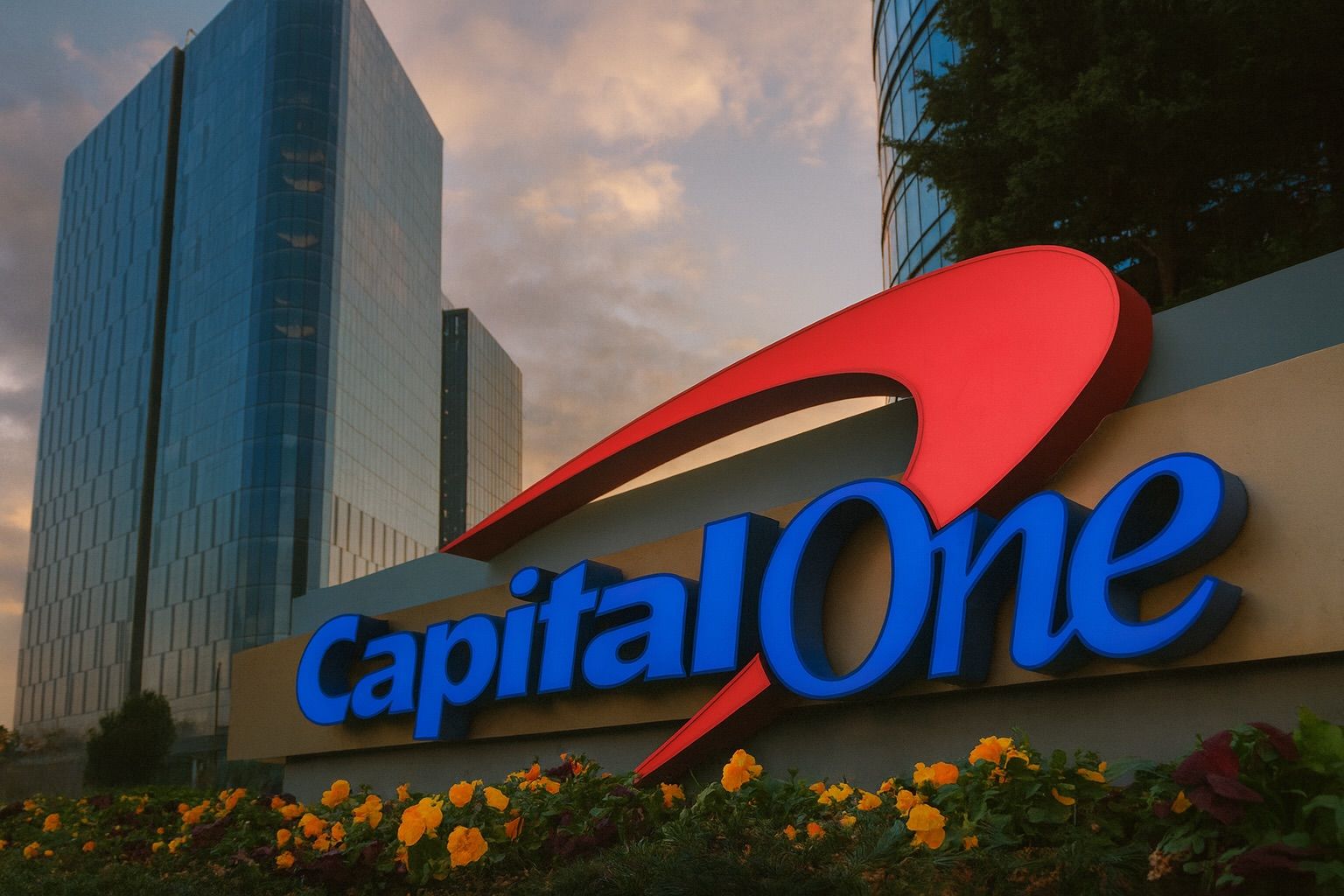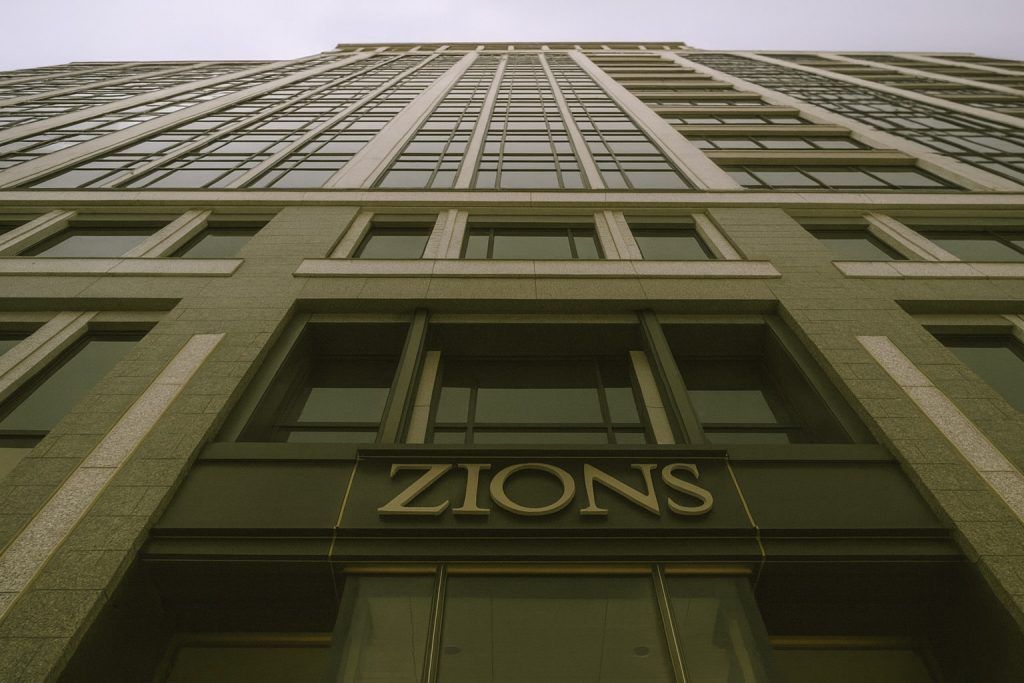- Stock Slumps After Rally: Capital One’s stock (NYSE: COF) tumbled nearly 6% on Oct. 16, 2025 to around $202, wiping out a week’s gains [1]. It had climbed to $215 just a day earlier [2], near multi-month highs, before bearish news hit.
- Upcoming Earnings in Focus: The bank reports Q3 earnings on Oct. 21 after market close. Analysts expect robust revenue growth but a year-over-year profit dip as loan-loss provisions rise [3]. COF has topped forecasts for four straight quarters [4].
- $425M Settlement Showdown: A $425 million class-action settlement over savings account interest is under fire. 18 U.S. states argue the deal shortchanges customers and saves Capital One ~$2.5 billion in unpaid interest [5]. Capital One “strongly denies” wrongdoing but calls the accord “reasonable” given litigation risks [6].
- Merger Makes COF a Card Giant: In May, Capital One completed a $35.3B takeover of Discover Financial, creating the U.S.’s largest credit card issuer and 8th-biggest bank [7] [8]. The Fed and OCC approved the deal with conditions and fines for Discover’s past issues [9]. Critics warn the merger may reduce competition and raise consumer costs [10] even as executives tout its benefits.
- Analysts Mostly Bullish: Wall Street remains optimistic. Consensus rating: “Moderate Buy” with an average price target around $252 [11] [12] (~25% above current). Barclays recently hiked its target to $257 (Overweight) [13]. A few voices urge caution, noting rising credit losses and the settlement risk.
- Sector & Macro Tailwinds: Financial stocks have been buoyed by strong big-bank earnings and a Fed rate cut in September [14]. Mid-October bank earnings (JPM, WFC, C) mostly beat forecasts on dealmaking and high rates [15], lifting sentiment. However, investors are on alert for credit “cracks” – “banks are a window into the U.S. economy,” says S&P’s Nathan Stovall [16] – so any hint of rising delinquencies could sour the mood.
- Technical Signals: COF’s steep drop breached short-term support. The stock now hovers near its 200-day moving average (~$203) [17], a key support level. It’s well below the 50-day (~$219) [18] after the latest sell-off. Relative strength has weakened, but trading volume spiked on the decline, suggesting traders are repositioning. A sustained break under $200 could signal further downside, whereas a bounce above $216 would resume its uptrend.
COF Stock Price – Volatile October Swing
Capital One’s stock has see-sawed in mid-October. It closed at $202.42 on Oct. 16, down 5.9% for the day [19], after a sharp afternoon sell-off. This reversal erased a short rally earlier in the week when COF climbed from ~$202 on Oct. 10 to $215.10 by Oct. 15 [20]. Traders attribute the sudden drop to a mix of legal headlines and broader bank jitters. Notably, U.S. regional bank stocks also fell ~4% on Oct. 16 amid a credit loss surprise at Zions Bank [21] [22], which spooked financial investors sector-wide.
Despite this pullback, COF remains up significantly in 2025. As of Oct. 15, shares had gained roughly 22% year-to-date [23]【33†L194-L202, fueled by rising interest income and a blockbuster merger (more below). The stock hit a 52-week high of ~$232 in late September【16†L323-L331】, and is still well above its 52-week low around $143. With the current ~$202 price, COF trades at roughly 8.5× forward earnings, reflecting both low valuation for a growth-driving bank and lingering caution over credit quality.
Short-term, all eyes are on the $200 level. This round number marks not only a psychological threshold but roughly coincides with the 200-day moving average (~$202.84) [24], which has provided support in past dips. If buyers defend this zone, COF could stabilize into earnings. On the upside, initial resistance sits around $215 (this week’s high), followed by stronger resistance near $225–$230 (September highs). Technical momentum has cooled – the stock’s RSI (relative strength index) fell out of overbought territory – but a decisive earnings beat or positive guidance could quickly reverse sentiment.
October News Roundup: Earnings, Legal Fights & Growth Moves
Earnings on Deck: Capital One will report third-quarter results on October 21, 2025. The Street anticipates solid growth in revenues but a moderation in profit from a year ago. Consensus estimates call for EPS around $4.20–$4.30 on roughly $13 billion in revenue (versus $5.25 EPS on $8.8B a year ago, pre-Discover) [25]. In Q2, Capital One delivered a huge earnings beat – $5.48 EPS vs. $4.03 expected – thanks to surging interest income and the Discover acquisition [26] [27]. However, Q3’s results will reflect higher expenses and loan-loss provisions as the bank bolsters reserves. Zacks Equity Research notes that while net interest income (NII) and fees likely rose on loan growth and heavy credit card usage, earnings “are likely to have declined” year-over-year due to a jump in costs and credit provisions [28]. In Q2, Capital One’s loan loss provision ballooned to $11.4B (from $3.9B a year prior) as it added Discover’s portfolio and braced for a cooler economy [29] [30]. Investors will closely scrutinize credit quality metrics – e.g. net charge-off rates and delinquency trends – when COF reports. “Investors will look for any changes in the credit environment,” cautions Gabelli analyst Mac Sykes [31], after several bankruptcies and a rise in card losses industry-wide.
$425M Settlement in Jeopardy: One of October’s biggest headlines is the legal clash over Capital One’s $425 million settlement with 360 Savings account customers. The class-action suit alleges Capital One quietly kept legacy savings customers at a 0.3% rate while newer 360 Performance accounts got 4+% interest [32]. Capital One agreed in May to pay $425M ($300M cash plus $125M in account credits) to affected depositors [33] – without admitting wrongdoing – to resolve the claims. However, a coalition of 18 state attorneys general (led by NY’s Letitia James) filed objections in federal court on Sept. 24 [34], arguing the deal is far too lenient on the bank. According to their filing, the settlement would compensate depositors for only 0.78% interest on losses, versus the ~3.5% they should have earned [35]. That gap would effectively let Capital One escape paying over $2.5 billion that customers missed out on [36], all without requiring it to change its practices. The states urged Judge David Novak to reject the settlement, saying Capital One shouldn’t be allowed to “continue short-changing customers” going forward [37] [38].
For its part, Capital One maintains the settlement is fair. In a public statement, the bank said it “strongly denies” the interest rate allegations, but believes the $425M accord is “reasonable” given the risks and costs of protracted litigation [39]. The plaintiffs’ attorney likewise called the payout a “good deal” in light of legal uncertainties [40]. A final approval hearing is set for November, making this a looming legal overhang for COF stock. If the judge or an appeals court sides with the states, Capital One could face re-negotiation of the settlement or even larger penalties – a scenario that would likely pressure the stock. Conversely, if the deal is approved, it removes an uncertainty (albeit after a $425M hit, which Capital One has presumably reserved for).
Notably, this savings-rate saga also drew regulatory attention. The Consumer Financial Protection Bureau (CFPB) had sued Capital One in early 2025 for failing to inform customers about the higher-yield account option, claiming consumers lost ~$2B in interest [41] [42]. (The CFPB later dropped its case pending the class settlement [43].) This episode underscores the increased regulatory scrutiny on bank deposit practices. It comes amid a broader environment where banks are under pressure to raise deposit rates or risk losing customers to higher-yield alternatives.
Other Legal Developments: In more positive legal news, Capital One recently settled a lawsuit by social media content creators over its popular browser extension, Capital One Shopping. In that case, creators alleged the free coupon-finding tool was stealing their affiliate commissions by inserting itself into online purchase referrals [44] [45]. In mid-September, Capital One reached a deal (terms undisclosed) to resolve the class-action, with a spokesperson asserting that Capital One Shopping “follows industry rules” and didn’t admit any wrongdoing [46]. The settlement is expected to get preliminary court approval by Nov. 17 [47]. By settling, Capital One puts to rest a potentially costly lawsuit and avoids an injunction against its Shopping tool, which is used by millions of customers. This outcome removes one minor overhang for the stock and illustrates management’s willingness to swiftly handle legal distractions.
Merger & Expansion Moves:Capital One’s biggest corporate move of 2025 was its blockbuster acquisition of Discover Financial Services, completed May 18. This transformative deal (valued at $35.3 billion) instantly boosted Capital One’s scale across credit cards, banking, and payments. Regulators noted the combination makes Capital One the #1 U.S. card issuer by balances and the nation’s 8th-largest federally insured bank with ~$638 billion in assets [48] [49]. Importantly, Capital One also inherited Discover’s payments network (Discover/Diners Club), positioning it to compete more directly with Visa and Mastercard [50]. “The combined entity will increase competition in payment networks, offer a wider range of products to our customers, increase our resources devoted to innovation and security,” said Discover’s interim CEO in praising the merger’s benefits [51].
However, not everyone was cheering. Consumer advocates at Better Markets argued the tie-up reduces competition and could lead to higher fees for customers [52], by eliminating a major standalone competitor. Regulators imposed some conditions: the OCC required Capital One to address any outstanding Discover compliance issues, and the Fed and FDIC together hit Discover with $250 million in fines for prior overcharging practices as part of approval [53]. Integration of Discover is a focal point for investors now. So far, it’s yielding big top-line gains – Q2 saw Capital One’s revenue jump ~31% YoY [54] – and management expects $2.5 billion in net synergies (e.g. cost cuts, scale efficiencies) from the deal in coming years [55]. But it’s also brought higher expenses and a one-time surge in credit reserves (an initial $8.8B allowance build for Discover’s loans in Q2) [56] [57]. Analysts will watch Q3 results for signs the Discover integration is on track: e.g. cost synergy realization, cross-selling progress, and whether Discover’s loan portfolio (heavy in cards) shows similar credit quality as legacy Capital One’s.
Beyond the Discover acquisition, Capital One continues to invest in technology and partnerships to drive growth. The bank has emphasized its push into digital banking and AI. CEO Richard Fairbank has repeatedly highlighted that Capital One is “rebuilding the company from the bottom of the tech stack up,” effectively turning into a “modern technology company that does banking.” [58] In the Q2 earnings call, Fairbank struck an optimistic tone about tech-driven opportunities, stating, “We are on the cusp of even greater opportunities… The opportunities are transformational, and we are well positioned in that quest.” [59] This suggests Capital One is leveraging AI and its tech talent (the company was a pioneer in cloud computing migration among banks) to improve customer experience and efficiency. Any updates on digital user growth, AI credit decisioning, or cost savings from tech in the upcoming earnings call could further inform the stock’s narrative.
Broader Industry Context: Capital One’s fortunes are intertwined with consumer spending and the credit cycle. As a major card lender, it benefits when the economy is strong (more card swipes, higher balances) but is vulnerable if consumers falter or unemployment rises. So far, consumer finances have been resilient. Big banks’ Q3 results suggest Americans kept spending through Q3 even as student loan payments resumed and savings dwindled [60] [61]. However, caution is creeping in: “Investors are rightfully on high alert for any change in asset quality trends,” wrote analysts at KBW after some surprise loan losses in the sector [62]. Even JPMorgan’s CEO Jamie Dimon warned recently about hidden risks in credit markets, quipping “when you see one cockroach, there are probably more” – urging banks to be vigilant [63] [64]. For Capital One, the key metrics will be credit card charge-off rates and delinquency trends. In Q2, net charge-offs rose to $3.06B (up 16% YoY) [65], though some of that was expected post-pandemic normalization. Analysts will want to see if credit losses are stabilizing or rising into year-end, especially in cards and subprime auto loans.
Meanwhile, macroeconomic shifts are a double-edged sword. Interest rates: The Federal Reserve surprised markets with a rate cut in September, trimming its benchmark to ~4.0% [66]. More cuts are expected in coming months as inflation cools. Lower rates help consumer borrowers (easier loan payments, potentially less defaults) but pinch banks’ net interest margins over time [67]. Capital One actually thrives on relatively high rates – its net interest margin was a strong 8.2% recently [68] – so further Fed easing in 2026 could moderate NII growth. On the other hand, economic growth has been steady and the jobs market, while softening, remains solid. “Banks are a window into the U.S. economy,” notes S&P Global’s Nathan Stovall [69]. If Capital One’s loan growth and credit performance stay healthy, it bodes well for the broader outlook (and vice versa). Investors will parse COF’s commentary on consumer health, deposit trends, and demand for credit. Notably, Capital One’s management previously guided that 2025 net interest income would be roughly flat vs 2024 for the combined company [70], anticipating some pressure from rate cuts and deposit competition – any update to that outlook will be market-moving.
Analyst Views and Forecasts
Wall Street sentiment on COF stock is cautiously bullish. According to MarketBeat data, the stock has 3 Strong Buy, 14 Buy, and 6 Hold ratings, with no sells [71]. The average 12-month price target is ~$252 [72] [73], implying significant upside from current levels. Several analysts raised targets in recent months following Capital One’s strong Q2 and the closing of the Discover deal. For instance, Barclays upped its target from $253 to $257 (Overweight) on Oct. 6 [74], citing benefits from the merger and solid credit trends. Deutsche Bank lifted its target to $224 (Hold) around the same time [75], and HSBC initiated a Hold with a $218 target [76] – indicating some see the stock as fairly valued after this year’s run. UBS remains bullish, recently reiterating a Buy and a ~$266 target despite trimming it slightly [77].
Bulls argue Capital One is undervalued relative to its growth. They point to the bank’s ability to consistently beat earnings forecasts (COF has surpassed estimates 4 quarters running [78]) and its attractive ~10%+ return on equity. The successful integration of Discover could unlock cost synergies and market share gains in payments. Plus, Capital One’s hefty capital return is a draw: the bank resumed buybacks this year and offers a growing dividend (currently yielding ~1.1% after a recent hike to $0.60 quarterly [79]). Many analysts see room for multiple expansion if credit holds up – COF trades at roughly 8x next year’s earnings, a discount to peers like American Express.
However, there are bearish voices tempering the enthusiasm. Some analysts on the sidelines worry that credit cycle risks are rising for Capital One. As a primarily consumer lender, COF could be exposed if unemployment ticks up or if consumers retrench on spending. Credit card charge-offs, in particular, bear watching – Capital One’s domestic card net charge-off rate was expected to be ~4.7% in Q3, down from pandemic highs but still elevated [80]. Any guidance of deteriorating credit metrics into 2026 would likely prompt downgrades. Bears also note that profit margins may have peaked: funding costs for banks have risen as deposits get repriced, and with the Fed now cutting rates, lucrative credit card yields could slide. Additionally, Capital One’s expenses are climbing due to tech investments and marketing. In Q3, noninterest expenses are projected to jump over 30% sequentially (partly from Discover) [81]. If efficiency gains from the merger don’t materialize, earnings could disappoint.
Overall, the sell-side expects moderate earnings growth ahead once one-time merger impacts pass. TipRanks data show analysts forecasting FY2025 EPS around ~$15.50 and FY2026 near ~$18–$19 (which aligns with the $15.65 consensus mentioned by MarketBeat [82]). That trajectory factors in slower growth next year then re-acceleration. Both bullish and bearish scenarios hinge on the consumer: as long as Americans keep spending and paying their bills, Capital One’s outlook is solid; if the economy downshifts, COF could underperform.
Notably, TS2.tech – a financial blog – highlighted the appeal of bank stocks this month, pointing out that Wells Fargo and peers trade near multi-year highs after strong earnings [83]. The site noted Wells Fargo’s consensus price target of ~$85 (about 8% upside) and that many big banks are flush with capital and poised for loan growth [84] [85]. This broader optimism in the banking industry can spill over to Capital One, if it shows it can harness its new scale and manage credit risks. As one analyst put it, rising loan demand and spending would signal strength, but investors will “look for any changes in the credit environment” as a warning sign [86]. That essentially sums up the split narrative on COF: growth versus credit quality.
Trading and Technical Outlook
From a trading perspective, COF has entered a critical testing zone. The late-October pullback brought shares down to long-term support. The 200-day simple moving average (SMA) sits around $202–$203 [87], roughly where the stock is now consolidating. A decisive break below this level on heavy volume could trigger technical selling – potentially opening downside toward the next support around $190 (an area of trading congestion in spring/summer). On the other hand, if buyers step in here (as they did during past dips in March and June), COF could stage a relief bounce. The 50-day SMA around $219 is a near-term ceiling for any rebound [88]. To regain bullish momentum, the stock would need to close back above ~$220, which would put it above all key moving averages and signal that the post-earnings trend is positive.
Volatility is elevated: COF’s 5-day price range is the widest it’s been in months, and options trading has been brisk. (Implied volatility spiked ahead of earnings; traders are buying both calls and puts to bet on a big move after results.) Notably, short interest in COF remains modest (around 2% of float), so there’s little evidence of a big bearish bet accumulating – meaning this drop appears driven by general market repositioning and news, rather than an attack by short sellers.
Key technical indicators: The relative strength index (RSI) for COF dropped from over 70 (overbought) in late September to the low-40s now, reflecting the recent cooling. That actually leaves room for a post-earnings rally if the news is good, as the stock is no longer overextended. Chart analysts will also watch the gap from Oct. 16 – COF gapped down at the open from ~$214 to ~$208 – as gaps often get filled if a stock recovers. Filling that gap (trading back to $214) would be a bullish sign confirming buyers are in control again.
In the options market, some bullish positioning has emerged at lower strikes: open interest data showed a build-up in January 2026 $220 calls and $180 puts (a possible risk-reversal trade by an institution to express upside with protection). While technicals in the immediate term flash caution, a stabilizing pattern or bullish candlestick formation after earnings could lure momentum traders back.
Conclusion
Capital One enters late October at a crossroads. The company is navigating a complex mix of tailwinds and headwinds: booming interest income and an acquisition-fueled expansion, set against rising credit costs and legal/regulatory scrutiny. The stock’s 2025 rally speaks to the success of its strategy so far – Capital One capitalized on high rates and consumer resilience – but the recent slide shows that confidence can be fickle in a changing environment.
Near-term, third-quarter earnings and the resolution of the $425M settlement are likely to drive COF’s next big move. A strong earnings report with upbeat guidance (and no new credit red flags) could quickly put the uptrend back on track. As Google News’ ts2.tech noted, big banks have surprised to the upside this season and are brimming with excess capital [89] [90]. If Capital One follows suit, its stock may recoup losses and head higher. Conversely, any disappointments – say, a cautious outlook, or a spike in delinquencies – would reinforce the recent bearish break.
Longer-term investors will be watching how well Capital One delivers on the promise of the Discover merger and its tech-driven evolution. By becoming a larger, more technologically advanced bank, COF aims to differentiate itself in an increasingly competitive industry. CEO Fairbank’s vision of a “technology company that does banking” [91] suggests Capital One is preparing for the future of finance, from AI-enhanced underwriting to digital-first customer service. That could justify a higher valuation if executed well.
For now, caution and opportunity coexist. Capital One faces a “show me” moment with Wall Street – to show that growth can be maintained safely. The broader banking sector context is mixed: economic signals are fairly positive, but regulators and investors have become more vigilant post-regional bank turmoil earlier in 2025. Capital One’s sturdy capital levels and diversified business (credit cards, commercial banking, auto loans) give it buffers to weather bumps. But it must prove that it can manage risks even as it chases rewards.
As one market strategist put it, the coming weeks will set the tone: “This earnings week will be one of the most important market events of 2025”, potentially confirming whether the expansion can stay on track or if investors should brace for turbulence [92]. For Capital One shareholders, that means a lot is riding on October’s news. Delivering solid results and resolving uncertainties could help COF stock regain its footing – and perhaps resume its climb toward analysts’ $250+ targets. On the flip side, any stumble might extend the slide. In short, Capital One now has to capitalize on its strengths and convince the market that its growth story remains intact.
Sources: Capital One Q2 earnings release [93] [94]; Reuters – Capital One/Discover merger approval [95] [96], state AGs object to settlement [97] [98]; MarketBeat analyst survey [99] [100]; ts2.tech analysis of bank earnings [101] [102]; CEO Fairbank quote from Q2 call [103]; Zacks forecast on Q3 [104]; and Yahoo Finance/Simply Wall St. news on the settlement challenge [105] [106].
References
1. stockanalysis.com, 2. stockanalysis.com, 3. www.nasdaq.com, 4. www.nasdaq.com, 5. www.reuters.com, 6. www.reuters.com, 7. www.reuters.com, 8. www.reuters.com, 9. www.reuters.com, 10. www.reuters.com, 11. www.marketbeat.com, 12. www.marketbeat.com, 13. www.marketbeat.com, 14. ts2.tech, 15. ts2.tech, 16. ts2.tech, 17. www.marketbeat.com, 18. www.marketbeat.com, 19. stockanalysis.com, 20. stockanalysis.com, 21. www.reuters.com, 22. www.reuters.com, 23. www.reuters.com, 24. www.marketbeat.com, 25. www.nasdaq.com, 26. www.investing.com, 27. www.investing.com, 28. www.nasdaq.com, 29. www.reuters.com, 30. www.reuters.com, 31. ts2.tech, 32. www.reuters.com, 33. www.reuters.com, 34. www.reuters.com, 35. www.reuters.com, 36. www.reuters.com, 37. www.reuters.com, 38. www.reuters.com, 39. www.reuters.com, 40. www.reuters.com, 41. bankautomationnews.com, 42. bankautomationnews.com, 43. www.reuters.com, 44. www.reuters.com, 45. www.reuters.com, 46. www.reuters.com, 47. www.reuters.com, 48. www.reuters.com, 49. www.reuters.com, 50. www.reuters.com, 51. www.reuters.com, 52. www.reuters.com, 53. www.reuters.com, 54. www.marketbeat.com, 55. www.investing.com, 56. www.investing.com, 57. www.investing.com, 58. www.investing.com, 59. www.investing.com, 60. ts2.tech, 61. ts2.tech, 62. www.reuters.com, 63. www.reuters.com, 64. www.reuters.com, 65. www.reuters.com, 66. ts2.tech, 67. ts2.tech, 68. www.marketbeat.com, 69. ts2.tech, 70. ts2.tech, 71. www.marketbeat.com, 72. www.marketbeat.com, 73. www.marketbeat.com, 74. www.marketbeat.com, 75. www.marketbeat.com, 76. www.marketbeat.com, 77. www.marketbeat.com, 78. www.nasdaq.com, 79. www.marketbeat.com, 80. finviz.com, 81. www.nasdaq.com, 82. www.marketbeat.com, 83. ts2.tech, 84. ts2.tech, 85. ts2.tech, 86. ts2.tech, 87. www.marketbeat.com, 88. www.marketbeat.com, 89. ts2.tech, 90. ts2.tech, 91. www.investing.com, 92. ts2.tech, 93. www.reuters.com, 94. www.reuters.com, 95. www.reuters.com, 96. www.reuters.com, 97. www.reuters.com, 98. www.reuters.com, 99. www.marketbeat.com, 100. www.marketbeat.com, 101. ts2.tech, 102. ts2.tech, 103. www.investing.com, 104. www.nasdaq.com, 105. www.marketbeat.com, 106. www.reuters.com





